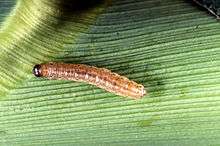Ostrinia
| Ostrinia | |
|---|---|
 | |
| Ostrinia nubialis | |
| Scientific classification | |
| Kingdom: | Animalia |
| Phylum: | Arthropoda |
| Class: | Insecta |
| Order: | Lepidoptera |
| Family: | Crambidae |
| Subfamily: | Pyraustinae |
| Tribe: | Pyraustini |
| Genus: | Ostrinia Hübner, 1825[1][2] |
| Synonyms | |
| |
Ostrinia is a genus of moths in the Crambidae family. Several of them, including the European Corn Borer, are agricultural pests.
Species
- Ostrinia avarialis Amsel, 1970
- Ostrinia dorsivittata (Moore, 1888)
- Ostrinia erythrialis (Hampson, 1913)
- Ostrinia furnacalis (Guenée, 1854) - Asian corn borer, Asian corn worm[3][4]
- Ostrinia kasmirica (Moore, 1888)
- Ostrinia kurentzovi Mutuura & Munroe, 1970
- Ostrinia latipennis (Warren, 1892)[4]
- Ostrinia marginalis (Walker, 1866)[2]
- Ostrinia nubilalis (Hübner, 1796) - European corn borer, European corn worm[2]
- Ostrinia obumbratalis (Lederer, 1863) - smartweed borer[2]
- Ostrinia ovalipennis Ohno, 2003[5]
- Ostrinia palustralis (Hübner, 1796)[4]
- Ostrinia penitalis (Grote, 1876)- American lotus borer[2][6]
- Ostrinia peregrinalis (Eversmann, 1852)
- Ostrinia putzufangensis Mutuura & Munroe, 1970
- Ostrinia quadripunctalis (Denis & Schiffermüller, 1775)
- Ostrinia sanguinealis (Warren, 1892)
- Ostrinia scapulalis (Walker, 1859)[3][4]
- Ostrinia zaguliaevi Mutuura & Munroe, 1970[4]
- Ostrinia zealis (Guenée, 1854)[4]
Disputed species
- Ostrinia maysalis P. Leraut, 2012, described from France.
Agricultural Problems
The Asian corn borer, Ostrinia furnacalis, is one of the biggest pests of maize in Asia, causing 10%-30% of yield losses in the field, and in some cases up to 80% yield loss.[7] These pests carry fungal pathogens (such as Bipolaris maydis and Curvularia lunata) which cause diseases such as Maydis leaf blight and curvularia leaf spot in the crop.
References
- ↑ "global Pyraloidea database". Globiz.pyraloidea.org. Retrieved 2011-10-11.
- 1 2 3 4 5 "Ostrinia nubialis". Integrated Taxonomic Information System. Retrieved July 6, 2007.
- 1 2 "Bugs". Systematic Reference Database on Korean Land Arthropoda. Cites Park, K. T. (1975). "Taxonomic study of the corn stem borer in Korea with allied species of the genus Ostrinia (Lep.; Pyralidae)". Korean Journal of Plant Protection. 14 (4): 221–225.
- 1 2 3 4 5 6 KIM CG, HOSHIZAKI S, HUANG YP, TATSUKI S, ISHIKAWA Y (1999). "Usefulness of mitochondrial COII gene sequences in examining phylogenetic relationships in the Asian corn borer, Ostrinia furnacalis, and allied species (Lepidoptera: Pyralidae)". Appl Entomol Zool. 34 (4): 405–412. ISSN 0003-6862.
- ↑ OHNO S (2003). "A new knotweed-boring species of the genus Ostrinia Hubner (Lepidoptera: Crambidae) from Japan". Entomol Sci. 6 (2): 77–83. doi:10.1046/j.1343-8786.2003.00007.x.
- ↑ "Ostrinia penitalis - "American Lotus Borer"".
- ↑ Wang, H., H. Dong, H. Qian, and B. Cong. "Laboratory Assessment of Entomopathogenic Nematode Symbiotic Bacteria to Control Maize Pest, Ostrinia Furnacalis, and Fungi Diseases, Bipolaris Maydis and Curvularia Lunata." Journal of Asia-Pacific Entomology 17.4 (2014): 823-27. Scopus. Web. 7 Dec. 2014
This article is issued from Wikipedia - version of the 6/7/2016. The text is available under the Creative Commons Attribution/Share Alike but additional terms may apply for the media files.